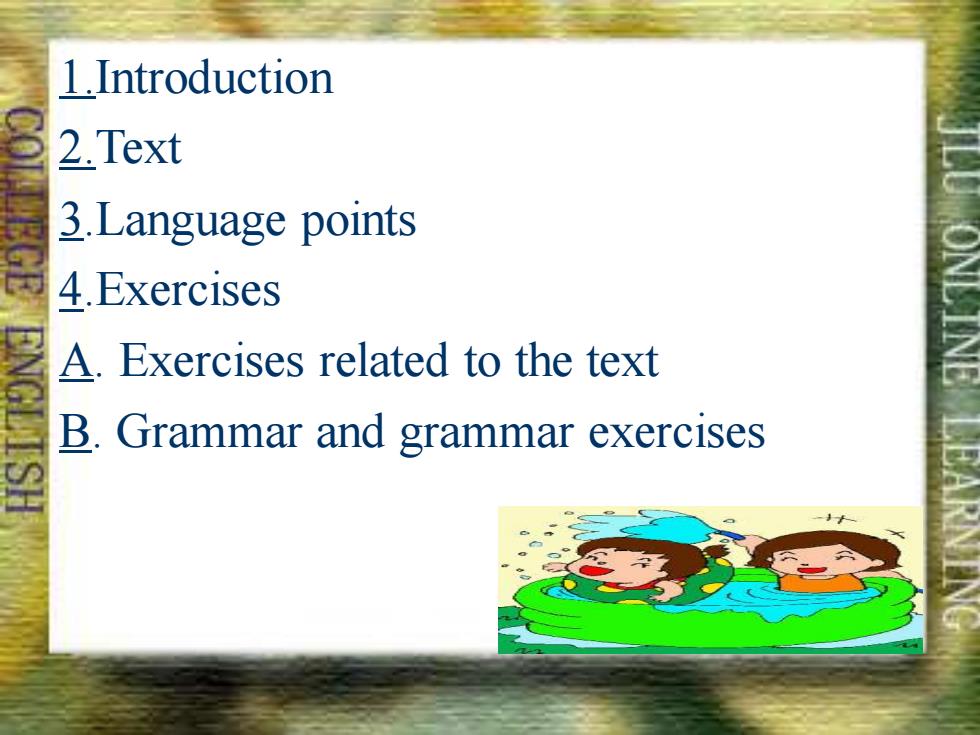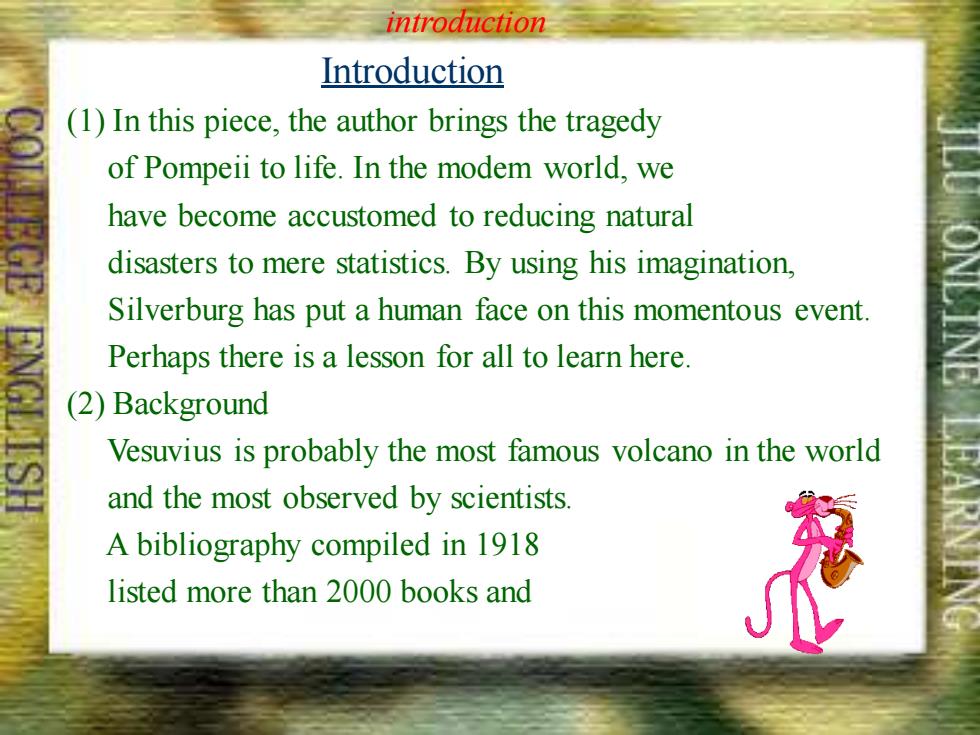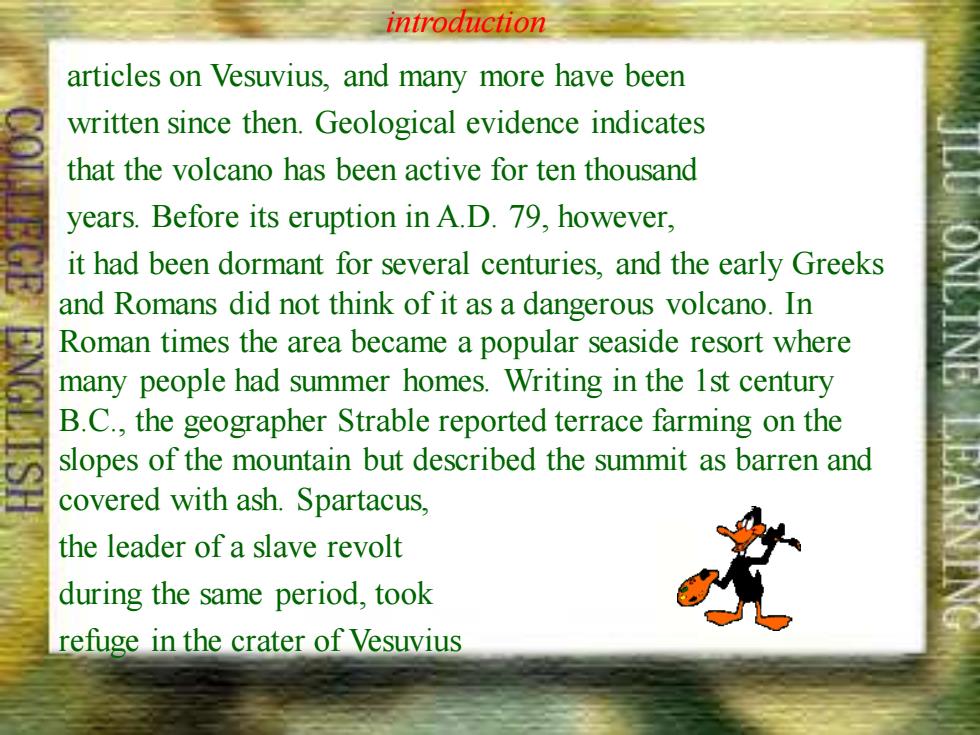
LESSON NINE Pompeii by Robert Silverburg
LESSON NINE Pompeii by Robert Silverburg

1.Introduction 2.Text 3.Language points 4.Exercises A.Exercises related to the text B.Grammar and grammar exercises
1.Introduction 2.Text 3.Language points 4.Exercises A. Exercises related to the text B. Grammar and grammar exercises

introduction Introduction (1)In this piece,the author brings the tragedy of Pompeii to life.In the modem world,we have become accustomed to reducing natural disasters to mere statistics.By using his imagination Silverburg has put a human face on this momentous event. Perhaps there is a lesson for all to learn here. (2)Background Vesuvius is probably the most famous volcano in the world and the most observed by scientists. A bibliography compiled in 1918 listed more than 2000 books and
Introduction (1) In this piece, the author brings the tragedy of Pompeii to life. In the modem world, we have become accustomed to reducing natural disasters to mere statistics. By using his imagination, Silverburg has put a human face on this momentous event. Perhaps there is a lesson for all to learn here. (2) Background Vesuvius is probably the most famous volcano in the world and the most observed by scientists. A bibliography compiled in 1918 listed more than 2000 books and introduction

introduction articles on Vesuvius,and many more have been written since then.Geological evidence indicates that the volcano has been active for ten thousand years.Before its eruption in A.D.79,however, it had been dormant for several centuries,and the early Greeks and Romans did not think of it as a dangerous volcano.In Roman times the area became a popular seaside resort where many people had summer homes.Writing in the 1st century B.C.,the geographer Strable reported terrace farming on the slopes of the mountain but described the summit as barren and covered with ash.Spartacus, the leader of a slave revolt during the same period,took refuge in the crater of Vesuvius
articles on Vesuvius, and many more have been written since then. Geological evidence indicates that the volcano has been active for ten thousand years. Before its eruption in A.D. 79, however, it had been dormant for several centuries, and the early Greeks and Romans did not think of it as a dangerous volcano. In Roman times the area became a popular seaside resort where many people had summer homes. Writing in the 1st century B.C., the geographer Strable reported terrace farming on the slopes of the mountain but described the summit as barren and covered with ash. Spartacus, the leader of a slave revolt during the same period, took refuge in the crater of Vesuvius introduction

introduction when he and his followers were being pursued by the Romans.Pompeii was rediscovered in 1748,but systematic excavation did not begin until 1860.About 2000 skeletons were found in hollowsleft in the ash by the bodies of the victims.The archeologists poured plaster of Paris into these hollows and so made plaster casts of men,women,children and domestic animals,looking exactly as they had at the moment of death.Many of them had their hands or cloths in their mouths,indicating that they were trying to protect themselves from the poisonous gas.Several were found clutching bags of coins and other valuables. (the end of the introduction)
when he and his followers were being pursued by the Romans. Pompeii was rediscovered in 1748,but systematic excavation did not begin until 1860. About 2000 skeletons were found in hollows left in the ash by the bodies of the victims. The archeologists poured plaster of Paris into these hollows and so made plaster casts of men, women, children and domestic animals, looking exactly as they had at the moment of death. Many of them had their hands or cloths in their mouths, indicating that they were trying to protect themselves from the poisonous gas. Several were found clutching bags of coins and other valuables. (the end of the introduction) introduction